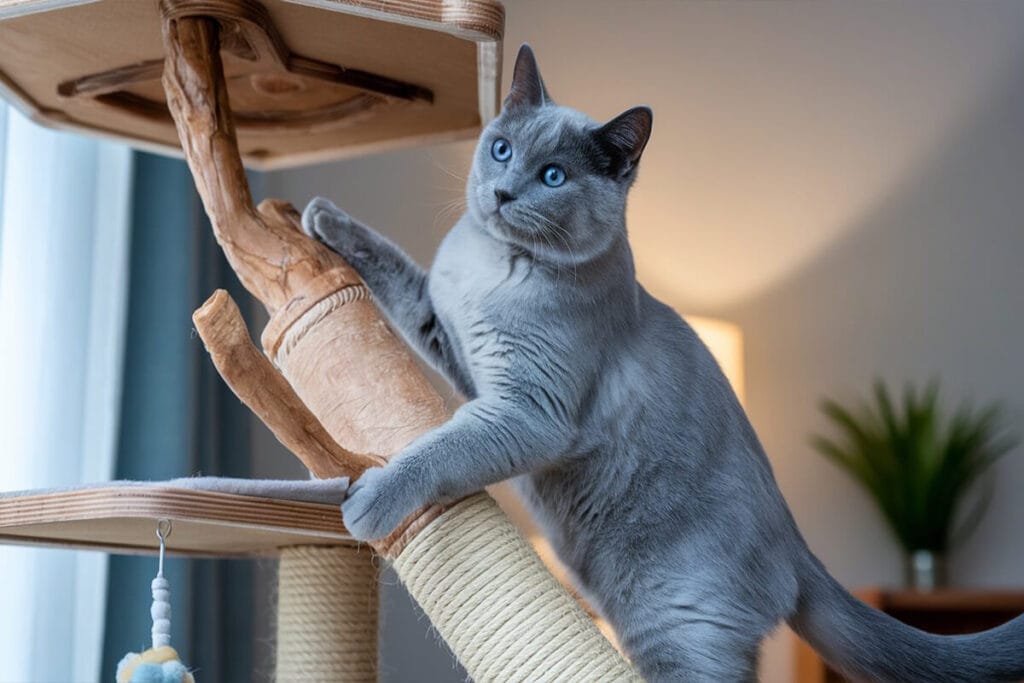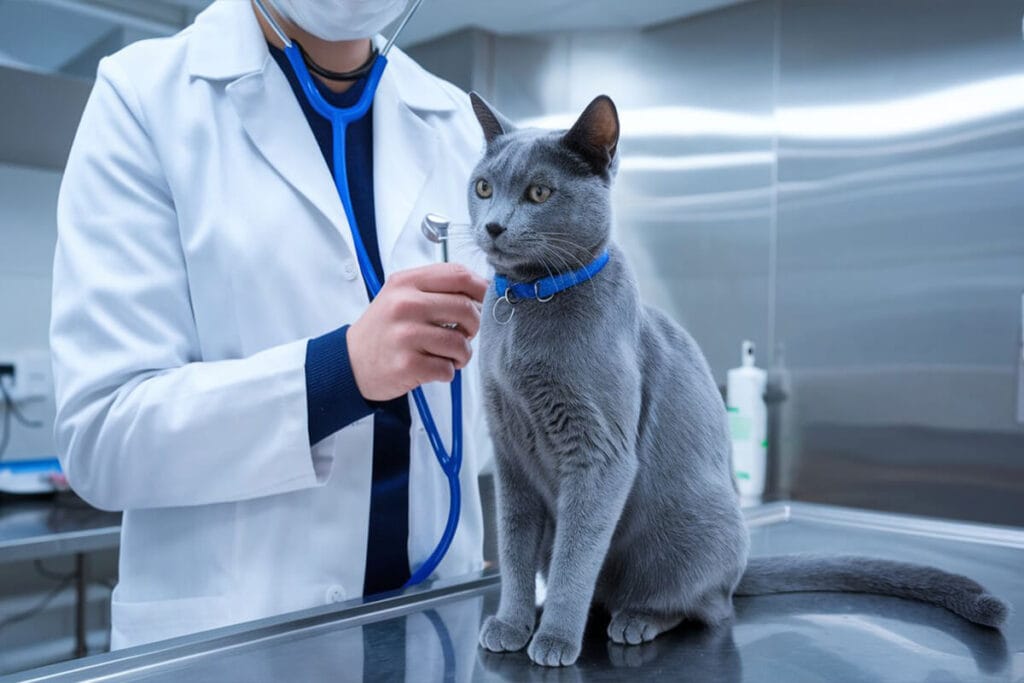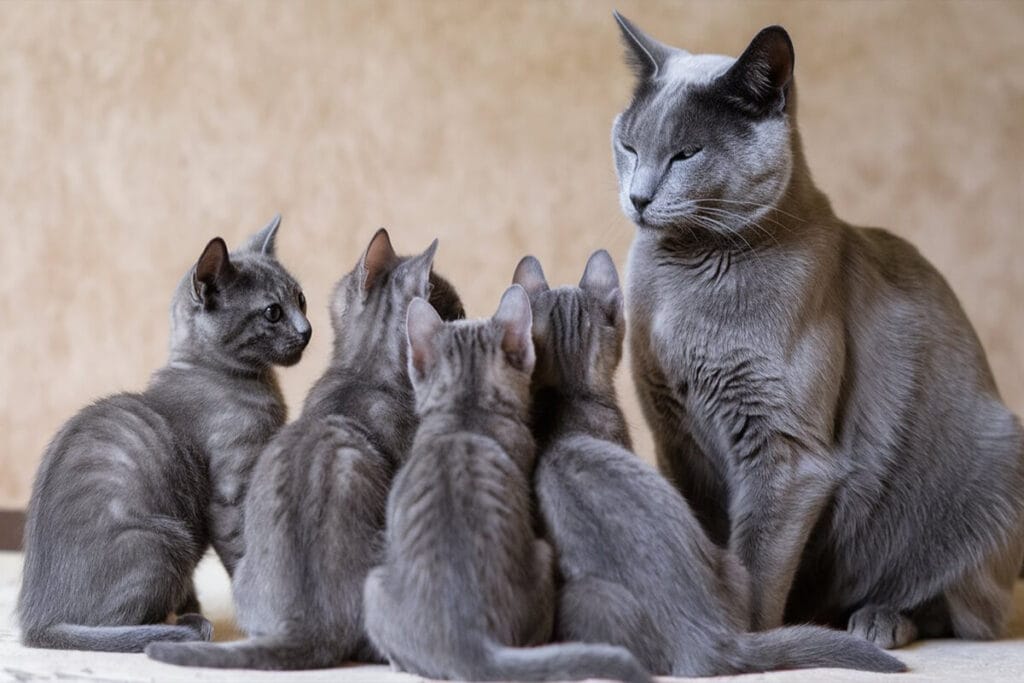Russian Blue cats have a reputation for their striking blue-gray coats, piercing green eyes, and elegant demeanor. But many potential owners ask, Are Russian Blue cats aggressive? This question often comes from concerns about feline aggression, especially for families or multi-pet households. While every cat has a unique personality, understanding this breed’s temperament helps owners create a positive and stress-free environment.
Are Russian Blue cats aggressive by nature? No, but their cautious behavior sometimes leads to misunderstandings. Russian Blue cats are smart, loyal, and kind. They tend to form strong bonds with their owners and prefer familiar routines. Some people mistake their reserved nature around strangers for aggression, but in reality, these cats take time to warm up to new people. With proper socialization and training, Russian Blues develop into affectionate and well-mannered pets.
In this article, pet behavior experts share insights into Russian Blue cat temperament, common misconceptions, and the best training techniques. Whether you’re a current owner or considering bringing one home, these expert-backed tips will help you raise a happy and well-adjusted feline companion.
Understanding Russian Blue Cat Temperament
Overview of Russian Blue Personality Traits
Russian Blue cats have a unique blend of traits that make them both fascinating and lovable companions. They show high intelligence, strong loyalty, and a deep sense of curiosity. Unlike some breeds that demand constant attention, Russian Blues prefer balanced interactions. They enjoy affection from their owners but also appreciate alone time. Their independent nature doesn’t mean they dislike people—it just means they set their own boundaries.
These cats also have a playful and energetic side. They enjoy interactive toys, puzzle feeders, and climbing structures. While they tend to be reserved with strangers, they form deep, trusting bonds with their families. Once a Russian Blue feels comfortable in a home, it often follows its owner from room to room, offering companionship without being overly clingy.
Are Russian Blue Cats Friendly or Aloof?
Russian Blues display a mix of friendliness and caution. With their owners, they are affectionate, devoted, and even talkative in a soft, sweet voice. They enjoy curling up next to their favorite person, sitting nearby while they work, or engaging in playful games.
However, these cats often act shy or distant around new people. Some may hide when guests arrive, while others simply observe from a safe distance. This reserved nature doesn’t mean they are aggressive; it’s just part of their personality. Once a Russian Blue warms up to someone, it will happily interact and seek attention. Early socialization helps them become more confident around unfamiliar faces.
Comparison with Other Cat Breeds in Terms of Aggression
Compared to more assertive or territorial breeds like the Bengal or Siamese, Russian Blue cats show a much gentler temperament. They rarely lash out unless provoked or frightened. Unlike breeds known for being highly dominant, Russian Blues tend to avoid confrontation and prefer peaceful environments.
While some breeds, like the Maine Coon or Ragdoll, immediately show friendliness to everyone, Russian Blues take a more selective approach. Their cautious nature helps them avoid unnecessary conflicts, but it also means they need time to adjust to new situations. Unlike naturally bold and social cats, Russian Blues thrive in stable, predictable settings.
When comparing aggression levels, Russian Blues rank among the least aggressive breeds. They might swat or nip if overstimulated, but they don’t show aggressive tendencies unless they feel extreme fear or distress. Understanding their temperament helps owners create a comfortable space where they feel safe, secure, and happy.
Common Misconceptions About Russian Blue Cat Behavior
Do Russian Blue Cats Bite? Separating Myth from Reality
Many people wonder, Do Russian Blue cats bite? This question often comes from concerns about aggression, but in reality, Russian Blues rarely bite out of hostility. Like all cats, they may nip or bite under certain circumstances, but their reasons usually have nothing to do with aggression. Are Russian Blue cats aggressive? No, but understanding their behavior helps owners prevent misunderstandings.

Russian Blues often use gentle nibbles as a form of communication. They might give a soft bite to get attention, show affection, or signal that they want playtime to stop. Kittens, especially, go through a biting phase while teething, but they outgrow it with proper training.
When Russian Blues bite with more force, it usually stems from overstimulation, fear, or pain. If an owner pets them for too long or in a sensitive spot, they might react with a quick bite to set boundaries. Recognizing these signals helps owners prevent unwanted biting and strengthen their bond with their
Signs of Stress or Fear That Might Be Mistaken for Aggression
Russian Blues, like any cat, display certain behaviors when they feel stressed or afraid. Some people mistake these signs for aggression, but they actually indicate discomfort or anxiety. Recognizing these signals allows owners to address the root cause instead of assuming their cat has an aggressive temperament.
Common signs of stress in Russian Blues include:
- Hiding or avoiding interaction – A stressed cat may retreat under furniture or into a secluded spot.
- Ears flattened or tail tucked – These body language cues signal discomfort or nervousness.
- Dilated pupils and tense posture – When a cat’s pupils widen significantly and its body stiffens, it likely feels threatened.
- Low growling or hissing – These vocal warnings mean the cat feels cornered or overstimulated.
- Sudden swatting or biting – A cat may lash out if it feels trapped or overwhelmed.
Many of these behaviors occur in unfamiliar environments or when a cat experiences sudden changes in routine. Instead of punishing a Russian Blue for reacting this way, owners should identify the stressor and help the cat feel safe.
Understanding Feline Aggression vs. Normal Cat Behavior
Aggression in cats can stem from several factors, including fear, territorial instincts, medical issues, or frustration. However, Russian Blues rarely show true aggression unless they feel extreme distress. Understanding the difference between natural cat behavior and real aggression prevents misinterpretation.
Normal cat behaviors that might seem aggressive:
- Play biting – Kittens and young cats often nip during play. This behavior is not true aggression, but it should be redirected with toys.
- Hunting instincts – Cats naturally chase and pounce. If a Russian Blue playfully ambushes its owner’s feet, it’s acting on instinct, not aggression.
- Boundary setting – A quick swat or a warning bite after prolonged petting means the cat has had enough, not that it dislikes interaction.
Signs of true aggression:
- Unprovoked lunging or attacking – A cat that repeatedly attacks without a clear trigger may have an underlying issue.
- Excessive hissing, growling, or tail thrashing – Constant defensive behavior suggests fear-based aggression.
- Biting with deep wounds – If a Russian Blue bites hard enough to break the skin regularly, it may be reacting to stress, pain, or trauma.
Most Russian Blue cats show calm, affectionate personalities when they live in a stable, loving home. Recognizing the difference between typical cat behavior and genuine aggression allows owners to respond appropriately and build a trusting relationship with their feline companion.
Expert Tips on Russian Blue Socialization
Importance of Early Socialization for a Well-Adjusted Cat
Early socialization plays a crucial role in shaping a Russian Blue cat’s temperament and confidence. Are Russian Blue cats aggressive? No, but without proper socialization, they may develop shy, anxious, or defensive behaviors in unfamiliar situations. Kittens that experience positive interactions with people, other pets, and new environments grow into well-adjusted, friendly adults.

The critical window for socialization begins as early as two to seven weeks of age. During this period, kittens absorb new experiences quickly and form long-term associations. Handling them gently, exposing them to different sounds, and introducing them to a variety of people help them develop into adaptable and secure cats. The more positive experiences they have early on, the less likely they are to react fearfully or defensively later in life.
Even after kittenhood, socialization remains essential. Russian Blue cats that continue to experience new situations in a controlled and positive way develop better coping skills. They learn to trust their owners, feel comfortable in different environments, and react calmly to changes in their routine. Are Russian Blue cats aggressive? No, but ensuring proper socialization helps them grow into confident and affectionate companions, making them more adaptable and less likely to exhibit stress-related behaviors.
Effective Socialization Techniques for Russian Blue Cats
Socializing a Russian Blue requires patience, consistency, and positive reinforcement. Since this breed tends to be reserved, forcing interactions can backfire and create fear instead of confidence. Using the right techniques makes the process smooth and stress-free.
1. Gradual Exposure to People
Start by introducing the cat to one person at a time in a calm setting. Let the cat approach on its terms instead of forcing physical contact. Encourage visitors to offer treats or engage in slow, gentle play.
2. Positive Reinforcement
Reward calm, curious behavior with treats, praise, or playtime. If a Russian Blue investigates a new person, allow it to retreat if needed and reinforce its courage with rewards. This approach builds trust without pressure.
3. Desensitization to Household Noises
Since sudden sounds can startle a Russian Blue, expose them gradually to common household noises. Play recordings of doorbells, vacuum cleaners, and other sounds at a low volume while offering treats to create positive associations.
4. Encouraging Exploration
Provide interactive toys, scratching posts, and climbing areas. Giving a Russian Blue safe opportunities to explore boosts confidence and prevents timid behavior. Rotate toys and change their environment slightly to encourage adaptability.
How to Introduce a Russian Blue to New People or Pets
Introducing a Russian Blue to new people or animals requires a slow, controlled approach. Are Russian Blue cats aggressive? Not naturally, but rushing introductions can cause fear-based reactions or defensive behavior. A step-by-step process helps the cat feel comfortable, reducing stress and encouraging positive socialization.
Introducing to New People
- Allow the Russian Blue cat to approach on its own rather than forcing interaction.
- Ask visitors to sit quietly and offer a favorite treat or toy to create a positive association.
- Avoid direct eye contact at first, as cats may see it as a sign of dominance or threat.
- Encourage multiple short, low-pressure interactions instead of a single, overwhelming encounter.
Introducing to Other Pets
- For other cats: Keep them in separate rooms at first. Swap bedding so they get used to each other’s scent. Gradually allow supervised interactions through a baby gate or cracked door before full introductions.
- For dogs: Keep the dog on a leash and let the Russian Blue observe from a safe distance. Praise good, calm behavior and gradually get closer over time. Always provide escape routes for the cat in case it feels overwhelmed.
- For small pets: Russian Blue cats have a natural prey drive, so interactions with birds, hamsters, or fish should always be supervised. Keep enclosures secure to prevent accidents or stress for both animals.
With patience, consistency, and positive reinforcement, Russian Blue cats learn to accept new experiences without anxiety. A structured introduction process helps ensure they feel safe, confident, and at ease in their home environment. Are Russian Blue cats aggressive? No, but a well-managed socialization process prevents fearful behaviors and strengthens their trusting nature.
Russian Blue Cat Training Tips for a Well-Behaved Pet
Positive Reinforcement Techniques for Reducing Unwanted Behaviors
Training a Russian Blue requires patience, consistency, and positive reinforcement. Punishing a cat for unwanted behavior rarely works and can create fear or anxiety. Instead, reinforcing good behavior with rewards helps a Russian Blue learn what is acceptable without stress.
1. Reward Good Behavior Immediately
Cats associate rewards with their most recent action. If a Russian Blue uses a scratching post instead of furniture, offer a treat or praise right away. Quick rewards help make a stronger link between what you do and the nice thing you get.
2. Redirect Instead of Scold
If a Russian Blue engages in unwanted behavior, redirect it to an acceptable alternative. For example, if it scratches the couch, guide it to a scratching post and reward it for using the correct surface. Redirecting prevents negative associations and keeps training positive.
3. Use Treats, Praise, and Play as Rewards
Each cat responds differently to rewards. Some Russian Blues prefer treats, while others enjoy praise or a favorite toy. Experiment with different rewards to see what motivates the cat most.
4. Be Consistent with Training
Inconsistent responses confuse a cat. If an owner sometimes allows counter-jumping but discourages it at other times, the cat won’t understand the rule. Setting clear, consistent expectations prevents mixed signals.
Best Cat Training Methods Recommended by Pet Behavior Experts
Pet behavior experts recommend training techniques that align with a cat’s natural instincts. Since Russian Blues are intelligent and observant, they respond well to structured, reward-based training methods.
1. Clicker Training for Clear Communication
Clicker training works well for reinforcing good behavior. By clicking and rewarding the moment a cat performs a desired action, the owner creates a strong association between the sound and positive reinforcement. This method helps with training tricks, stopping unwanted behaviors, and improving responsiveness.
2. Target Training for Better Focus
Using a small stick or finger as a target, owners can teach Russian Blues to follow commands. When the cat touches the target, it receives a reward. Over time, this method helps train behaviors like sitting, staying in a designated area, or coming when called.
3. Scheduled Playtime to Reduce Excess Energy
Russian Blues need physical and mental stimulation. Regular interactive play sessions prevent boredom-related behaviors like excessive meowing, furniture scratching, or nighttime activity. Wand toys, puzzle feeders, and treat-dispensing toys keep them engaged and reduce destructive tendencies.
4. Litter Box Training and Reinforcement
Although Russian Blues naturally use a litter box, keeping it clean and placed in a quiet, accessible area prevents accidents. If the cat stops using it, checking for medical issues or stress triggers helps solve the problem. Praising proper litter box use reinforces good habits.
How to Encourage Friendly and Affectionate Behavior
Russian Blues show affection in their own way. Some enjoy lap time, while others prefer sitting close by without direct contact. Encouraging friendly behavior helps deepen the bond between the cat and its owner.
1. Respect Their Space and Boundaries
Russian Blues bond deeply with their owners but don’t like being forced into interactions. Giving them the freedom to approach on their terms builds trust. If a cat retreats, allowing it to do so without pressure prevents stress.
2. Create Positive Associations with Touch
Some Russian Blues enjoy petting, while others take time to warm up to it. Start by gently stroking areas they like, such as under the chin or behind the ears. Pairing touch with treats or soft praise makes them more receptive to physical affection.
3. Use a Soft, Calm Voice
Talking to a Russian Blue in a soothing tone reassures them. These cats respond well to gentle voices and often “talk” back with soft meows when they feel comfortable.
4. Engage in Interactive Play
Playing together strengthens the human-cat bond. Wand toys, laser pointers, and treat-filled puzzles encourage engagement while reinforcing positive interactions. Playtime also helps reduce stress, making Russian Blues more relaxed and affectionate.
5. Offer Cozy Sleeping Spots Near You
Russian Blues enjoy resting in safe, warm spaces. Placing a soft bed near the owner’s favorite chair or bed encourages closeness. Over time, the cat may seek out snuggles on its own.
With patience, consistency, and positive reinforcement, Russian Blues develop strong, loving relationships with their owners. Encouraging friendly behavior while respecting their personality leads to a trusting and affectionate bond.
Veterinarian Advice on Managing Cat Behavior Issues
When to Seek Professional Help for Aggression or Anxiety
Russian Blue cats typically have a calm and gentle temperament, but sudden aggression or anxiety may indicate an underlying issue. Knowing when to seek professional help prevents behavioral problems from worsening and ensures the cat’s well-being.

1. Persistent Aggressive Behavior
If a Russian Blue hisses, growls, swats, or bites frequently and without a clear trigger, consulting a veterinarian or pet behaviorist becomes necessary. Unprovoked aggression may stem from fear, territorial instincts, or medical conditions.
2. Sudden Changes in Behavior
A cat that was previously friendly but starts hiding, avoiding interaction, or acting aggressively may be experiencing pain or emotional distress. Sudden personality shifts often signal illness, stress, or trauma.
3. Excessive Hiding or Fearful Reactions
While Russian Blues tend to be reserved around strangers, extreme fearfulness—such as running away from familiar people, constant hiding, or reacting aggressively to routine situations—suggests anxiety or past trauma. A professional can recommend desensitization techniques or calming strategies.
4. Destructive or Compulsive Behaviors
If a Russian Blue starts overgrooming, excessively scratching furniture, or displaying compulsive behaviors like pacing or tail-chasing, a vet or behaviorist should assess potential causes. These behaviors often result from anxiety, boredom, or underlying medical conditions.
5. Litter Box Avoidance Due to Stress
When a Russian Blue suddenly stops using the litter box, stress, anxiety, or a medical issue might be the cause. A vet visit helps rule out urinary tract infections or kidney problems before addressing behavioral factors.
Health Conditions That May Cause Changes in Temperament
Health problems often influence a cat’s behavior. If a Russian Blue shows unusual aggression, irritability, or lethargy, a medical condition could be the root cause. Identifying and treating the issue restores the cat’s normal temperament.
1. Dental Pain or Oral Issues
Tooth decay, gum disease, or oral infections can cause discomfort, making a normally gentle cat irritable or aggressive when touched near the mouth. Regular dental check-ups help prevent these issues.
2. Arthritis or Joint Pain
Older Russian Blues may develop arthritis, leading to pain and reduced mobility. If a cat suddenly resists handling or avoids jumping onto furniture, joint discomfort may be affecting its mood. A veterinarian can provide pain management solutions.
3. Hyperthyroidism
An overactive thyroid can cause hyperactivity, restlessness, increased appetite, and irritability. If a Russian Blue suddenly becomes aggressive or anxious along with changes in weight or eating habits, thyroid testing may be necessary.
4. Urinary Tract Infections (UTIs) or Kidney Disease
Painful urination, frequent litter box trips, or accidents outside the litter box may indicate a UTI or kidney issue. Cats experiencing discomfort may become more defensive or withdrawn. Early veterinary intervention helps manage these conditions.
5. Neurological Disorders or Cognitive Decline
Older Russian Blues may develop neurological issues or cognitive dysfunction, leading to confusion, irritability, or unusual behaviors. If a cat seems disoriented or has trouble recognizing familiar people or routines, a vet assessment can help determine the best care plan.
Tips for Keeping a Russian Blue Happy and Stress-Free
Russian Blue cats thrive in a stable, low-stress environment. By meeting their physical, mental, and emotional needs, owners can prevent anxiety and encourage a calm, happy demeanor.
1. Maintain a Consistent Routine
Russian Blues prefer predictability. Feeding, playtime, and sleep schedules should stay as consistent as possible. Sudden changes in routine can cause stress and behavioral issues.
2. Provide Safe and Quiet Spaces
These cats enjoy having cozy hiding spots where they can retreat when feeling overwhelmed. Soft beds, cat trees, or enclosed spaces give them a sense of security.
3. Engage in Daily Interactive Play
Russian Blues need mental and physical stimulation. Interactive toys, wand play, and puzzle feeders keep them engaged, prevent boredom, and reduce stress-related behaviors.
4. Use Positive Reinforcement and Gentle Handling
Building trust through gentle petting, soft-spoken interactions, and treats encourages a Russian Blue to feel comfortable and secure. Avoid forcing interaction, as these cats prefer approaching on their own terms.
5. Introduce New Experiences Gradually
If introducing a Russian Blue to a new environment, pet, or person, take it slowly. Rushing introductions can overwhelm them. Using treats and reassuring tones helps ease transitions.
6. Keep the Litter Box Clean and Accessible
A dirty litter box causes stress and may lead to avoidance. Scoop waste daily and place the litter box in a quiet, low-traffic area to ensure comfort.
7. Monitor Health Regularly
Routine vet check-ups prevent health-related temperament changes. Watching for early signs of illness allows for prompt treatment, keeping the cat happy and pain-free.
Creating a calm, enriched environment ensures a Russian Blue remains affectionate, relaxed, and well-adjusted. With proper care, these intelligent and sensitive cats thrive in a loving home.
Veterinarian Advice on Managing Cat Behavior Issues
When to Seek Professional Help for Aggression or Anxiety
Russian Blue cats usually have a calm and affectionate temperament, but some may develop aggression or anxiety due to stress, fear, or medical issues. While minor behavioral changes are normal, persistent aggression or excessive anxiety requires professional intervention. Knowing when to seek help ensures that a Russian Blue remains happy and well-adjusted.
1. Frequent Unprovoked Aggression
If a Russian Blue repeatedly hisses, growls, swats, or bites without an obvious trigger, a pet behaviorist or veterinarian should assess the issue. Aggression can stem from fear, territorial instincts, or an underlying medical problem. Without intervention, the behavior may escalate, making interactions stressful for both the cat and its owner.
2. Sudden Personality Changes
A Russian Blue that was previously friendly and affectionate but becomes withdrawn, aggressive, or overly fearful may be experiencing distress. A veterinarian can rule out medical causes, while a behaviorist can determine if stress, trauma, or environmental changes are contributing to the issue.
3. Excessive Hiding and Fearfulness
While Russian Blues tend to be reserved, extreme fearfulness—such as constantly hiding, flinching at touch, or avoiding family members—suggests anxiety. If the cat refuses to leave hiding spots for extended periods, reacts aggressively when approached, or becomes extremely skittish, professional help can identify the root cause and offer solutions.
4. Destructive or Obsessive Behaviors
Stress and anxiety may cause a Russian Blue to engage in compulsive behaviors such as excessive grooming, persistent scratching, or pacing. Overgrooming can lead to bald patches and skin irritation, while destructive scratching may damage furniture and walls. A professional can recommend behavior modification techniques to reduce these stress-related habits.
5. Litter Box Avoidance Linked to Anxiety
If a Russian Blue suddenly stops using the litter box, a veterinarian should check for medical issues first. If no physical illness is found, a behaviorist can help identify environmental stressors—such as changes in routine, new pets, or household conflicts—that may be causing the avoidance.
6. Aggressive Reactions Toward Other Pets or People
If a Russian Blue reacts aggressively toward other animals or household members, the introduction process may not have gone smoothly. A pet behavior expert can provide guidance on proper socialization and techniques to ease tensions, ensuring a peaceful coexistence.
Seeking professional help early prevents behavioral issues from worsening. With expert guidance, a Russian Blue can regain confidence, feel more secure, and return to its naturally affectionate self.
Health Conditions That May Cause Changes in Temperament
A sudden change in a Russian Blue’s behavior may indicate an underlying medical issue. Pain, discomfort, or hormonal imbalances can cause mood swings, irritability, or increased aggression. Recognizing health-related behavioral changes ensures timely veterinary care.
1. Dental Problems and Oral Pain
Tooth decay, gum disease, or oral infections can cause significant discomfort, leading a Russian Blue to become irritable or even aggressive when its mouth or face is touched. Difficulty eating, drooling, or pawing at the mouth may indicate a dental issue that requires veterinary attention.
2. Arthritis and Joint Pain
As Russian Blues age, they may develop arthritis or joint pain, making movement uncomfortable. A once-active cat that becomes withdrawn, avoids jumping, or resists being handled may be experiencing pain. A veterinarian can recommend joint supplements, pain management strategies, or lifestyle adjustments to improve mobility and comfort.
3. Hyperthyroidism
An overactive thyroid can cause sudden personality changes, including hyperactivity, increased vocalization, restlessness, or irritability. If a Russian Blue displays unusual energy spikes, weight loss despite increased appetite, or excessive meowing, a vet should test for thyroid imbalances.
4. Urinary Tract Infections and Kidney Disease
Urinary discomfort may cause a cat to avoid the litter box or react defensively when touched near its lower body. Straining to urinate, frequent bathroom trips, or crying in pain suggest a urinary tract infection or kidney issue. Prompt veterinary care prevents complications and relieves discomfort.
5. Neurological Disorders or Cognitive Decline
In older Russian Blues, neurological conditions or cognitive decline may cause confusion, personality shifts, or unusual behaviors. A cat that appears disoriented, forgets familiar routines, or suddenly becomes anxious may benefit from veterinary evaluation and supportive care.
Regular health check-ups help detect medical conditions before they significantly affect a Russian Blue’s temperament. Addressing health issues early ensures a comfortable and happy life for the cat.
Tips for Keeping a Russian Blue Happy and Stress-Free
A well-adjusted Russian Blue thrives in a calm, structured environment. Reducing stress, providing mental stimulation, and maintaining a stable routine contribute to a cat’s overall happiness and emotional well-being. Are Russian Blue cats aggressive? Not when they feel secure and cared for. Creating the right environment helps prevent stress-related behaviors and strengthens their affectionate nature.
1. Maintain a Consistent Routine
Russian Blue cats feel secure when their daily routine remains predictable. Regular meal times, play sessions, and sleep schedules create stability, reducing stress and anxiety. Sudden changes, such as a new feeding schedule or different sleeping arrangements, may make them uneasy.
2. Provide Safe and Comfortable Spaces
Russian Blue cats appreciate quiet, cozy areas where they can retreat and relax. Soft beds, enclosed cat trees, or elevated perches give them a sense of security. Providing hiding spots, such as covered cat caves or designated quiet zones, helps them feel safe during stressful situations.
3. Engage in Interactive Play
Mental and physical stimulation prevent boredom-related stress. Wand toys, feather teasers, and puzzle feeders keep Russian Blues engaged while strengthening the bond between cat and owner. Short, frequent play sessions cater to their natural hunting instincts and release pent-up energy.
4. Use Positive Reinforcement and Gentle Handling
These cats respond best to kindness and patience. Using treats, praise, and soft-spoken interactions encourages affectionate behavior. Avoid forcing interaction—Russian Blues enjoy socializing on their own terms and may need time to warm up to new experiences.
5. Introduce New Experiences Gradually
Whether meeting new people, adjusting to a new home, or encountering another pet, Russian Blue cats need time to adapt. Slow, controlled introductions with positive reinforcement reduce anxiety and encourage curiosity instead of fear.
6. Keep the Litter Box Clean and Accessible
A dirty litter box creates stress and may lead to avoidance. Scooping waste daily and placing the litter box in a quiet, low-traffic area ensures comfort. Using unscented litter and maintaining a consistent type prevents unnecessary stress.
7. Monitor Health with Regular Vet Visits
Routine veterinary check-ups help detect health issues before they affect behavior. Annual wellness exams, dental cleanings, and vaccinations keep a Russian Blue in optimal health, reducing the risk of temperament changes due to illness.
8. Offer a Balanced Diet for Optimal Health
A nutritious diet contributes to overall well-being. High-quality protein, essential vitamins, and proper hydration support a Russian Blue’s physical and mental health. A well-fed cat with proper nutrition remains energetic, happy, and less prone to stress.
Russian Blue cats thrive when they feel safe, loved, and well cared for. If owners ask, Are Russian Blue cats aggressive?, the answer lies in how the cat is raised and its environment. With a stable home, positive reinforcement, and good health care, a Russian Blue remains a loving and devoted companion.
Conclusion
Russian Blue cats have a reputation for being gentle, intelligent, and affectionate companions. However, many potential owners wonder, Are Russian Blue cats aggressive? The truth is, Russian Blue cats are not naturally aggressive, but like all felines, they may display defensive behaviors in certain situations. Understanding their temperament, recognizing the causes of aggression, and using proper training techniques can ensure a well-adjusted and friendly cat.

Early socialization plays a crucial role in shaping a Russian Blue’s personality. Introducing them to new people, pets, and environments in a calm and gradual manner prevents fear-based aggression and helps them develop confidence. Russian Blue cats may appear reserved at first, but with patience and positive reinforcement, they form strong bonds with their owners and enjoy companionship on their own terms.
If a Russian Blue cat shows unexpected aggression or anxiety, identifying the cause is essential. Medical conditions, stress, or environmental changes can impact their temperament. Regular veterinary check-ups help detect health issues that might cause behavioral changes. If aggression persists despite a stable home environment, consulting a pet behavior expert can provide tailored strategies to address the issue.
Owners who provide a stable routine, mental stimulation, and a stress-free environment will have a happy and affectionate Russian Blue cat. Interactive play, positive reinforcement, and gentle handling encourage trust and prevent unwanted behaviors. Russian Blue cats thrive in calm households where they feel secure, and when given the proper care, they reward their owners with loyalty and affection.
So, are Russian Blue cats aggressive? No, but like any pet, their behavior depends on their upbringing, environment, and health. By understanding their unique personality and needs, owners can ensure a harmonious and loving relationship with their Russian Blue companion.
Read More About the Grey Cat Breed On this Page
Learn More about Pets and Breeds From Here
You Can Find Some Good stuff for your Furry Cat on Pet MD Official.
